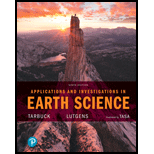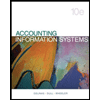
Applications and Investigations in Earth Science (9th Edition)
9th Edition
ISBN: 9780134746241
Author: Edward J. Tarbuck, Frederick K. Lutgens, Dennis G. Tasa
Publisher: PEARSON
expand_more
expand_more
format_list_bulleted
Textbook Question
Chapter 5.1, Problem 2A
List these magmas in order from the lowest to highest silica (Si02) content basaltic (mafic), rhyolitic (felsic), and andesitic (intermediate).
________________________________________________________________________
Expert Solution & Answer
Learn your wayIncludes step-by-step video

schedule02:15
Students have asked these similar questions
Which of the following is NOT a type of fossil?
a) Cast
b) Mold
c) Carbon film
d) Sediment
Indicate in the blank spaces below, the section of the balance sheet where the following items are
reported. Use the following code to identify your answer:
PPE Property, Plant, and Equipment
I Intangibles
O Other
N/A Not on the balance sheet
_____ 1.Goodwill ______ 6. Research and Development Costs
_____ 2.Land Improvements ______ 7. Land
_____ 3.Buildings ______ 8. Franchises
_____ 4.Accumulated Depreciation ______ 9. Licenses
_____ 5.Trademarks ______ 10. Equipment
Identify the following as intangible assets (IA), natural resources (NR), or some other asset (O). Salt mine
Chapter 5 Solutions
Applications and Investigations in Earth Science (9th Edition)
Ch. 5.1 - Define magma....Ch. 5.1 - List these magmas in order from the lowest to...Ch. 5.1 - Based on their silica content, which of these...Ch. 5.1 - Which of these magmas tend to produce effusive...Ch. 5.1 - Which of these magmas produce the most explosive...Ch. 5.1 - What two types of volcanoes are associated with...Ch. 5.1 - With what type of volcano are andesitic...Ch. 5.1 - Use Figure 5.2 to complete Question 8 Fill in each...Ch. 5.2 - Measure the slope of Mauna Loas flank using a...Ch. 5.2 - What factor contributes to the gentle slopes...
Ch. 5.2 - What are the small "hills' covered in vegetation...Ch. 5.2 - Figure 5.4 is an image of an eruption on Kilauea,...Ch. 5.2 - Does the lava shown in Figure 5.4 most likely have...Ch. 5.2 - Based on your answer to Question 5, what is the...Ch. 5.3 - Using a protractor, measure the slope of SP Crater...Ch. 5.3 - How does the slope of SP Crater compare to the...Ch. 5.3 - Using the scale, measure the height of SP Crater...Ch. 5.3 - Based on your answer to Question 3, compare the...Ch. 5.3 - Based on Figure 5.5, compare the size of the...Ch. 5.3 - What is the name for the ejected lava fragments...Ch. 5.3 - Given the nature of the materials that make up a...Ch. 5.3 - Using Figure 5.7 arid a piece of siring, measure...Ch. 5.3 - Would you describe the lava that produced this...Ch. 5.4 - Would you describe this as an effusive or...Ch. 5.4 - What name is given to the plume rising from the...Ch. 5.4 - List the primary materials that compose the Mount...Ch. 5.4 - Measure the slope angle near the top of Mount Hood...Ch. 5.4 - Measure the slope near the base of Mount Hood...Ch. 5.4 - Describe how the slope of Mount Hood changes from...Ch. 5.4 - What is the primary cause of the change in slope...Ch. 5.4 - Describe the differences you noticed between the...Ch. 5.5A - Based on the image in Figure 5.11, what type of...Ch. 5.5A - This image also shows that the upper portion of...Ch. 5.5A - What term is used for mudflows that form on...Ch. 5.5A - Can mudflows be triggered when a volcano is not...Ch. 5.5A - Notice in Figure 5.12 that the Osceola Lahar was...Ch. 5.5A - Using a string, measure the distance on Figure...Ch. 5.5A - Assuming that the Osceola Lahar traveled at an...Ch. 5.5A - If monitoring stations were established around the...Ch. 5.5A - What material would be incorporated into a lahar...Ch. 5.5A - What value is gained from dating prehistoric...Ch. 5.5B - What name is given to fast-moving currents of hot...Ch. 5.5B - The average chemical composition of the ash from...Ch. 5.5B - Did the magma that produced the May 18, 1980,...Ch. 5.5B - Use Figure 5.1619, which shows the area destroyed...Ch. 5.5B - Use Figure 5.14 to determine how much volcanic ash...Ch. 5.5B - What is the furthest state from the volcano that...Ch. 5.5B - In what general direction were the upper-level...Ch. 5.5B - Which of the three types of volcanoes discussed...Ch. 5 - Define magma _________________ __________________Ch. 5 - What type of magma has the lowest silica Si02...Ch. 5 - What type of magma has the lowest viscosity?...Ch. 5 - Does the lava flow shown In Figure 5.17 have a...Ch. 5 - What name is given to the nongaseous material...Ch. 5 - Which type of magma tends to produce effusive...Ch. 5 - Which type of magma tends to produce lava domes?Ch. 5 - What two types of volcanoes are associated with...Ch. 5 - Describe the basic shape of a shield volcano.Ch. 5 - What type of volcano is shown in Figure 5.18 1?Ch. 5 - What name is applied to the material being mined...Ch. 5 - Describe how the shape slope of a composite...Ch. 5 - What type of volcanoes are Earths largest?Ch. 5 - What hazard does Mount Rainier pose to the Seattle...Ch. 5 - Figure 5.19 shows a profile view of Newberry...Ch. 5 - What are the small structures that are visible on...
Additional Science Textbook Solutions
Find more solutions based on key concepts
2. Julie drives 100 mi to Grandmother’s house. On the way to Grandmother’s, Julie drives half the distance at 4...
Physics for Scientists and Engineers: A Strategic Approach, Vol. 1 (Chs 1-21) (4th Edition)
Match each of the following items with all the terms it applies to:
Human Physiology: An Integrated Approach (8th Edition)
1.6 Read the labels on products used to wash your dishes. What are the names of some chemicals contained in tho...
Chemistry: An Introduction to General, Organic, and Biological Chemistry (13th Edition)
41. A reaction in which A, B, and C react to form products is first order in A, second order in B, and zero ord...
Chemistry: Structure and Properties (2nd Edition)
Which type of cartilage is most plentiful in the adult body?
Anatomy & Physiology (6th Edition)
All of the following terms can appropriately describe humans except: a. primary consumer b. autotroph c. hetero...
Human Biology: Concepts and Current Issues (8th Edition)
Knowledge Booster
Similar questions
- Indicate in the blank spaces below, the appropriate group heading for financial reporting purposes. Use the following code to identify your answer: PPE Property, Plant, and Equipment NR Natural Resources I Intangible Assets O Other N/A Not on the balance sheet Goodwill7.Timberlands Land improvements8.Franchises Development costs for a patented product 9.Licences Accumulated depreciation—buildings10.Equipment Trademarks11.Depreciation expense Research costs12.Landarrow_forwardIdentify the following as intangible assets (IA), natural resources (NR), or some other asset (O). Oil wellarrow_forwardCreate four new fixed asset accounts – Account type: Fixed Assets, detail type: Buildings and Accumulated Depreciation (where appropriate), account names: Original Cost (a sub account of Building) and Accumulated Depreciation (a sub account of Building), and Land with Account type: Fixed Asset, detail type: Land. I saw a sample but don't we have to make a check also? How are the 4 accounts created also?arrow_forward
- With reference to IAS 16 (Property, Plant and Equipment), discuss the differences between “thecost model” and “the revaluation model” for the subsequent measurement of property, plant andequipment after its initial recognition.arrow_forwardCharacteristics of Depreciation Methods Below is a common list of depreciation methods and characteristics related to depreciation. Depreciation Methods a. Straight-line depreciation method b. Declining balance depreciation method c. Units-of-production depreciation method when actual units produced increases over the life of the asset Characteristics 1. Results in depreciation expense that decreases over the life of the asset. 2. Results in depreciation expense that increases over the life of the asset. 3. Allocates the same amount of cost to each period of a depreciable assets life. 4. Calculated by multiplying a constant depreciation rate by depreciable cost. 5. Calculated by applying a constant depreciation rate to the assets book value at the beginning of the period. 6. Results in lowest income taxes in early years of the assets life. 7. Consistent with the matching principle. Required: Match one or more of the depreciation methods with each characteristic.arrow_forwardAnswer all questionsarrow_forward
- Explain the similarities and differences among depreciation, depletion, and amortization. Provide examplesarrow_forwardDo your research on 5 depreciation methods. Identify the appropriate applications, advantages, and disadvantages of each method.arrow_forwardIllustrate the features of the MAC RS depreciation method?arrow_forward
- Listed below are several terms and phrases associated with operational assets. Pair each item from List A (by letter) with the item from List B that is most appropriately associated with it. List A List B _____ 1. Depreciation _____ 2. Goodwill _____ 3. Amortization _____ 4. Natural resources _____ 5. Intangible assets _____ 6. Copyright _____ 7. Trademark a. Exclusive right to display a word, a symbol, or anemblem.b. Exclusive right to benefit from a creative work.c. Assets that represent contractual rights.d. Oil and gas deposits, timber tracts, and mineraldeposits.e. Purchase price less fair value of net identifiableassets.f. The allocation of cost for plant and equipment.g. The allocation of cost for intangible assets.arrow_forwardWhich of the following statements is correct with respect to a Gantt chart?a. The x-axis of a Gantt chart shows a time line.b. The y-axis shows the activities of a project.c. The Gantt chart itself does not show all dependencies among activities.d. The Gantt chart is named after 19th-century industrialist Henry Gantt.e. All of these statements are correct.arrow_forwardPlease answer please help mearrow_forward
arrow_back_ios
SEE MORE QUESTIONS
arrow_forward_ios
Recommended textbooks for you
 Financial Reporting, Financial Statement Analysis...FinanceISBN:9781285190907Author:James M. Wahlen, Stephen P. Baginski, Mark BradshawPublisher:Cengage LearningCentury 21 Accounting Multicolumn JournalAccountingISBN:9781337679503Author:GilbertsonPublisher:Cengage
Financial Reporting, Financial Statement Analysis...FinanceISBN:9781285190907Author:James M. Wahlen, Stephen P. Baginski, Mark BradshawPublisher:Cengage LearningCentury 21 Accounting Multicolumn JournalAccountingISBN:9781337679503Author:GilbertsonPublisher:Cengage- Principles of Accounting Volume 1AccountingISBN:9781947172685Author:OpenStaxPublisher:OpenStax College
 Pkg Acc Infor Systems MS VISIO CDFinanceISBN:9781133935940Author:Ulric J. GelinasPublisher:CENGAGE L
Pkg Acc Infor Systems MS VISIO CDFinanceISBN:9781133935940Author:Ulric J. GelinasPublisher:CENGAGE L

Financial Reporting, Financial Statement Analysis...
Finance
ISBN:9781285190907
Author:James M. Wahlen, Stephen P. Baginski, Mark Bradshaw
Publisher:Cengage Learning

Century 21 Accounting Multicolumn Journal
Accounting
ISBN:9781337679503
Author:Gilbertson
Publisher:Cengage



Principles of Accounting Volume 1
Accounting
ISBN:9781947172685
Author:OpenStax
Publisher:OpenStax College

Pkg Acc Infor Systems MS VISIO CD
Finance
ISBN:9781133935940
Author:Ulric J. Gelinas
Publisher:CENGAGE L